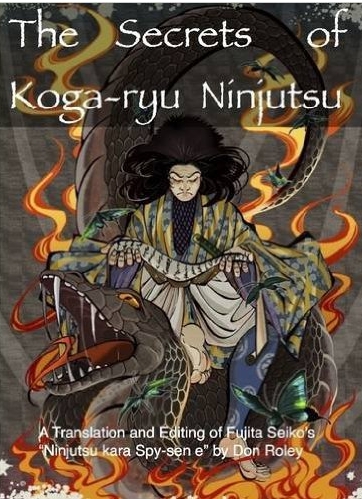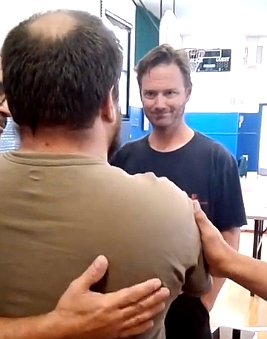 Secrets of Koga-Ryu Ninjutsu is one of the English translations works by Don Roley, prominent member of Masaaki Hatsumi’s Bujinkan martial arts organization and himself fluent in Japanese. Roley is a polarizing and sometimes controversial figure, as he regularly takes on frauds, fakes, and exaggerators in the martial arts — particularly those who pretend to ninjutsu or other Japanese styles.
Secrets of Koga-Ryu Ninjutsu is one of the English translations works by Don Roley, prominent member of Masaaki Hatsumi’s Bujinkan martial arts organization and himself fluent in Japanese. Roley is a polarizing and sometimes controversial figure, as he regularly takes on frauds, fakes, and exaggerators in the martial arts — particularly those who pretend to ninjutsu or other Japanese styles.
I’ve known Don Roley personally for many years. I find him to be a man of incredible character, consistency, and courage. Don also achieved a kind of viral fame in October of 2016 when several goons from the Black Dragon Fighting Society showed up at a seminar Don was giving in Kentucky. The goons tried to intimidate Roley, but he stood his ground, telling them to their faces that he had no respect for them or for their group. In other words, Don is good people, and I’ve enjoyed many an hour reading various English translations he has done of Japanese martial works like the Shoninki and the Bansenshukai.
The interest in ninjitsu/ninjutsu is easily explained: Don is head of the Colorado Springs Bujinkan Dojo. After spending 15 years in Japan learning the art of the ninja, he moved back to his native Colorado where he now lives with his family. He holds the highest rank in the Japanese language that the government tests for and has translated a series of books on the subject of ninjutsu. Aside from his wide range of expertise in Japanese history, culture, and related subjects (which give him insight into the significance of some of the references and background of translated works), he did a short stint in the military and thus brings to the table experience with night patrols and other things that ordinary academics lack.
Don has, in fact, been called the Western world’s foremost authority on Koga-ryu ninjutsu. He is sought after as a teacher of martial arts, most specifically ninjutsu. When one of his Japanese teachers had to go on business trips, Don Roley was the student asked to take over teaching the man’s classes.
Don Roley doesn’t take himself very seriously — and has a reputation for mocking those who do. His reputation is such that he is called “the Dr. House of the Bujinkan,” a man who knows his stuff and is unwilling to compromise in the name of playing nice. In this vein, Don’s work writes rings around the inferior “translations” of people like Antony Cummins, who don’t speak Japanese and whose work doesn’t exhibit what I would call a rigorous discipline where research (and the conclusions drawn from that research) is concerned. Don’s work is the opposite; he knows what he’s doing, he’s diligent in his research, he’s equipped with the tools needed to provide cogent interpretations of the works he translates, and he actually cares about the work rather than his own aggrandizement. The martial arts world in which Roley swims is littered with inflated egos. He has made more than a few enemies because he doesn’t care which of those balloons he pops.
As for Secrets of Koga-ryu Ninjutsu, Roley’s translation is a rough interpretation of Fujita Seiko’s Ninjutsu kara Spy-sen e (From Ninjutsu to Spy Warfare). Roley has changed certain things to make the text easier to read, taking care not to omit important information. “Many of the references and such that Fujita used would be unfamiliar to an audience almost a century later and half a world away,” he explains. “For that matter, some of the comments he made referring to current events at the time of his writing baffle many Japanese readers today.” Roley omitted two chapters from Fujita Seiko’s original text entirely — one on getting along with various Japanese subcultures, which is irrelevant to comtemporary readers, and one concerning Fujita Seiko’s time as a “living god” that was basically Fujita boasting about himself. (It appears in Roley’s translation of Fujita Seiko’s autobiography, however.)
There is quite a lot in Secrets of Koga-ryu Ninjutsu that is relevant to the modern reader. Beyond merely the historical curiosity that might make it of interest, the book is full of wisdom and lore that I found fascinating. Some of these can be extrapolated as life advice, in much the same way that Miyamoto Musashi’s text on swordsmanship, The Book of Five Rings, is used as an inspirational text for leaders, businessmen, athletes, and so on.
“In the beginning,” writes Fujita, “ninjutsu was seen as a way of self-defense and escape. The ninja would bring his hands together in front of his chest, chanting a spell and, as soon as he did it, by means of mysterious arts of various types, they would disappear from sight, or a beast would appear to allow him to use them to rise to the heavens or sink into the earth. Those left behind would be left in a state of shock at the sudden disappearance right in front of their eyes. These were known as the arts of heaven, earth, and man and called the three aspects of escape, or the five elemental ways of escape based on the elements of wood, fire, earth, metal, and water, and there were many ways to specialize them. But man cannot become earth as long as he is alive. By means of laying flat against cliffs and protrusions, the ninja uses earth escape (doton). Submerging in water, letting only your head rise above the water and concealing that with foliage is the use of water escape (suiton). Hiding in teh hollows of a tree is wood escape (mokuton). Thinking in this way, anyone can use these methods in their normal life. But the ninja expands his knowledge and skill in these aspects and as a result reaches peaks that the normal person cannot even suspect.”
The book is, understandably, absolutely chocked full of nuggets like these. Every time I read it over, I find some new piece of wisdom to ponder — some of it practical, some of it whimsical, but all of it fascinating. The text is worth acquiring and reading for this reason alone.
According to Roley, Secrets of Koga-ryu Ninjutsu was written in the hopes that people would take lessons from it and look at their own lives in a new light. Fujita hoped readers would continue their research into some of the chronicled matters and then find new ways of doing things. This is not, in other words, a likely candidate for transforming the reader into a Koga-ryu ninja. “I really am scared,” Roley writes, “that someone will try something like the parachute [technique described in the text] and get badly injured or worse.”

Of more significance is Roley’s commentary on Koga-ryu elsewhere. In his blog, he points out that anyone claiming to teach Koga-ryu ninjutsu is a liar. “Let me stress this,” he says. “Anyone who has ever claimed to been made a teacher of Fujita’s Koga ryu ninjutsu is a complete fraud. In addition, all the bozos I have seen making such fraudulent claims are also completely inept in terms of martial arts, and a few of them have even managed to get themselves criminal records… The problem is, with Fujita safely dead, martial arts con-men are able to now claim that they have some sort of link to him. He can’t defend himself against these frauds that prey on the gullible. The simple truth is, Fujita was quite vocal in saying that he had never taught his art of ninjutsu to anyone. He is known for passing along certain tricks, such as how he passed along a method for judging distances to the head of a style of shurikenjutsu. And he studied other arts like Namban-setto ryu kempo that he taught to others. But he stated time and time again that he was going to let the ninjutsu style he had learned from his grandfather die with him. [emphasis added]”
Fujita Seiko was born to a family with ties to the Koga-ryu that worked as Ommitsu (secret agents) for the shogunate. His father was never trained in the arts, for there was no real use for them despite his being a police officer. His grandfather, though, was old enough that, while he might not have served as a spy, he was taught the art as a child at the very least. Fujita’s grandfather would eventually offer to train the impetuous Fujita in the art of ninjutsu if the boy would learn to behave and apply himself to the training. Fujita accepted and went on to live what Roley calls “a fairly interesting life,” dabbling in mysticism and becoming involved in the military. By the end of World War II, Fujita was in Japan and, convinced the Americans sought to destroy his culture, took it upon himself to learn and help preserve many of the traditional martial arts of Japan. He was a well-respected martial artist and scholar who never overtly demonstrated his ninja training. A heavy drinker, he eventually died of liver damage, never leaving a successor.
“Today, Fujita’s artifacts and historical books lie gathering dust in museums like the one at Iga Ueno and Odawara,” Roley writes. “If he had a successor, they would be with him/her instead. There are many works by Fujita on ninjutsu, many of which have yet to be translated into English. I have read them and I consider it a sad state of affairs that I know more about the Koga ryu that Fujita learned than anyone claiming to teach it.”
As part of that body of translated work, Secrets of Koga-ryu Ninjutsu is well worth your time. Roley is not merely a translator; he is an able guide, taking the reader with him on this journey into martial history. You can pick up all of Don’s available translation work on this page. I highly recommend you do so.